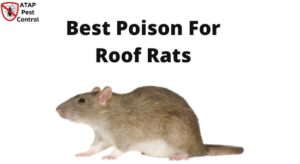Rats on your property are never a good thing, especially if they’re inside your home. Their scurrying can keep you awake at night, and they leave debris and feces wherever they go. Sometimes rats in attic removal cost you an arm and leg but today we’re going to share some ways through which you control rats.
Roof rats are one of the two most common rat species in the United States. They prefer high places around your property, as the name implies, but they can also infiltrate your home. Learn more about identifying and controlling roof rats by reading this guide.

What Exactly Are Roof Rats?
Roof rats, also known as black rats (despite their color variation), are rodents that can be found on roofs, attics, rafters, the tops of trees, and other high places around your home. These rats are omnivores, eating foliage such as seeds, leaves, and stems as well as small prey such as birds and insects. If they have access to crops, they will eat them as well. Roof rats consume approximately 15 grams of food and 15 milliliters of water per day. They weigh 2-8 ounces and have a body length of 5 to 7.5 inches. Their tail will be as long as their body. What is the best poison for roof rats?
Roof Rat Evidence
The majority of homeowners will not see the rats themselves, but will instead find evidence of rats. If you notice any of the following signs, you may have roof rats on your property:
Roof rat droppings are capsule-shaped with blunt ends and measure 1/4 to 1/2 inch long. They are usually shiny black, but the color can vary depending on the rat’s diet. Rat feces are three times larger than mouse feces.
Urine Stains and Odors – While rodent urine may be difficult to see with the naked eye, it will be visible with a UV flashlight. If you smell urine but can’t see it, try shining a flashlight in the area where you think the urine is. The urine will appear in the form of fine drops or streaks.
Roof rats prefer to gnaw on wood, but they can also cause damage to electrical wiring, food packaging, and other materials. Holes with rough edges are typically 2 inches in diameter or larger.
Roof rats will create paths, also known as tracks or runways, to mark their movements. Indoors, tracks will appear as clean, 3/4 to 1 inch wide paths through dirt or dust. Outdoors, tracks are smooth, well-packed paths that are devoid of vegetation or foliage. Grease marks on walls may appear next to tracks.
Sights and Sounds – Rodents are nocturnal and use their sleeping time to hide. They may be seen or heard during the day. Roof rats are known to make gnawing, scratching, and digging sounds.
Roof Rats: How to Get Rid of Them
The most effective method for getting rid of roof rats is to use a three-tiered approach: sanitation, exclusion, and baiting and trapping. Learn why all three steps are required to successfully remove roof rats from your property.
STEP 1: Sanitation
Sanitation is the most effective way to keep roof rats away from your property and control existing infestations.
Roof rats must have access to food and water in order to thrive. They will live wherever there is food and water. Consider the following to reduce roof rats on your property:
- Instead of cardboard boxes that can easily be gnawed through, store food in metal or plastic containers with tight-fitting lids.
- Remove any clutter, such as paper or cardboard, that rats may use to construct their nests.
- Store dog food and other pet food in tightly sealed food containers. Never leave your dog’s food or water out overnight.
- Remove grass clippings, weeds, and other unwanted vegetation from the area around your home.
STEP 2:Exclusion
Roof rats can get into homes and structures through cracks as small as half an inch. They may also fit through improperly installed or ill-fitting doors, windows, air vents, or screens.
You can greatly reduce the ease of entry for rodents (and thus the population size) by implementing the following measures:
- Caulk, wood, mesh, or other appropriate materials should be used to seal any openings larger than a quarter inch.
- Use copper mesh or Xcluder cloth to seal off gaps where pipes enter homes.
- Flood drains with large openings should be replaced.
- Check that all doors and window screens are properly fitted. If necessary, use door sweeps.
- In our rodent control guide, you can learn more about rodent exclusion.
STEP 3: Trapping and baiting (Population Reduction)
Roof rats can be dangerous because they spread disease. They can also chew through electrical wires and water pipes, causing damage to your home. Once you’ve determined that you have roof rats, you can work to get rid of them in the following ways:
Baiting – Baiting attracts and kills rodents by using poisons, also known as rodenticides. Baiting is an excellent outdoor activity. Rodents will detect the bait and return to consume it until the poison kills them. Instead of dying in your home, the rats will either die outside or in a trap (located inside the bait station).
Bait is placed in bait stations to protect other wildlife and to keep rain from moldering the bait. Ensure that fresh bait is always available until the rats stop feeding. Stations are routinely checked.
ADVICE
We strongly advise against using rat bait indoors. After ingesting a lethal dose of bait, a rat may crawl into an inaccessible area to die. This can make removal of the carcass impossible, resulting in a foul odor and insect infestation.
Trapping – Trapping is recommended for indoor use. Trapping allows you to know when the rat was killed, eliminates the odor of a slowly decaying rat carcass, and does not require the use of rodenticides.
Rat traps should be installed flush with the walls in areas where rats congregate, such as train tracks and paths. For maximum efficiency, the opening or trigger end should be perpendicular to the wall. If you’re using two traps, line them up parallel to the wall, with the trigger end facing outward.
ATAP is the best company and people recommend it as the best rat removal company near me when they search. Many best rat poisons are also considered to kill attic rats. For assistance, can call at (773)701-7705.
